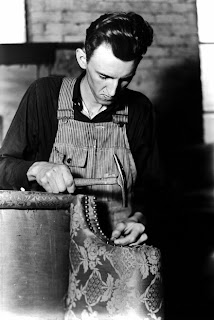Hines photographs started to make a point to the public that children were being deprived of childhood ,health ,education and a chance for a future. Hines work on the subject changed the publics attitude towards child labor and strict laws were enforced .
In 1912 Hine started a family and by 1913 had established himself as a successful social welfare photographer , for the next seven years Hine continued to travel ,exhibit and lecture for the NCLC . In 1917 Hine excepted a position with The National Red Cross spending the next two years photographing refugees and displaced civilians in war torn Europe . During the 1920's Hine undertook various assignments and in 1924 was to be awarded a medal by The Arts Directors Club of New York at an exhibition of Advertising Arts ,Hine found it difficult to make a living at photography even though he was famous ,then in 1930 Hine was hired to photograph the construction of the Empire State Building . In 1931 Hines work was exhibited in the Yonkers Art Museum and Hine then went on to publish a book in 1932 ,Men and Work .
In 1939 , sponsorship for Hine retrospective of specially made large prints were exhibited at the riverside museum in New York , with the works of Paul Strand and Alfred Stieglitz were to be included too.
Lewis .W,Hine died in 1940 and his son Croydon donated his fathers prints and negatives to The Photo League after finding little interest elsewhere ,eventually they were then donated again to The George Eastman House.
Lewis Hine's black and white images of people and children really strikes me , he manages to capture reality and the individuals personality in their working environment in his work . Lewis Hines is also famous for capturing images of child labor between 1908 and 1912 . Each of the images below tells a story of the working conditions , the age of the workers and some intricate machines and work needed to be done in their every day lives.
I have Chosen photographs of people in their working environment as this is what I have been doing in my unit 208 ,theme 2 .
 The light and detail is fab in all of the shots on this page, Lewis has got the workers and their machinery/placement in the frame and you can tell the line of work each individual is undertaking ,showing a story in all of his images .The shots draw you in, and you seem to be wanting to know more about the real people in the photographs.
The light and detail is fab in all of the shots on this page, Lewis has got the workers and their machinery/placement in the frame and you can tell the line of work each individual is undertaking ,showing a story in all of his images .The shots draw you in, and you seem to be wanting to know more about the real people in the photographs. |
| The Butcher |
 |
| And His Tools ! |
All of the pictures above have been taken for research from the website below an not used for any other publishing uses .
http://www.multimedialibrary.com/framesml/IM12/IM12.asp









No comments:
Post a Comment